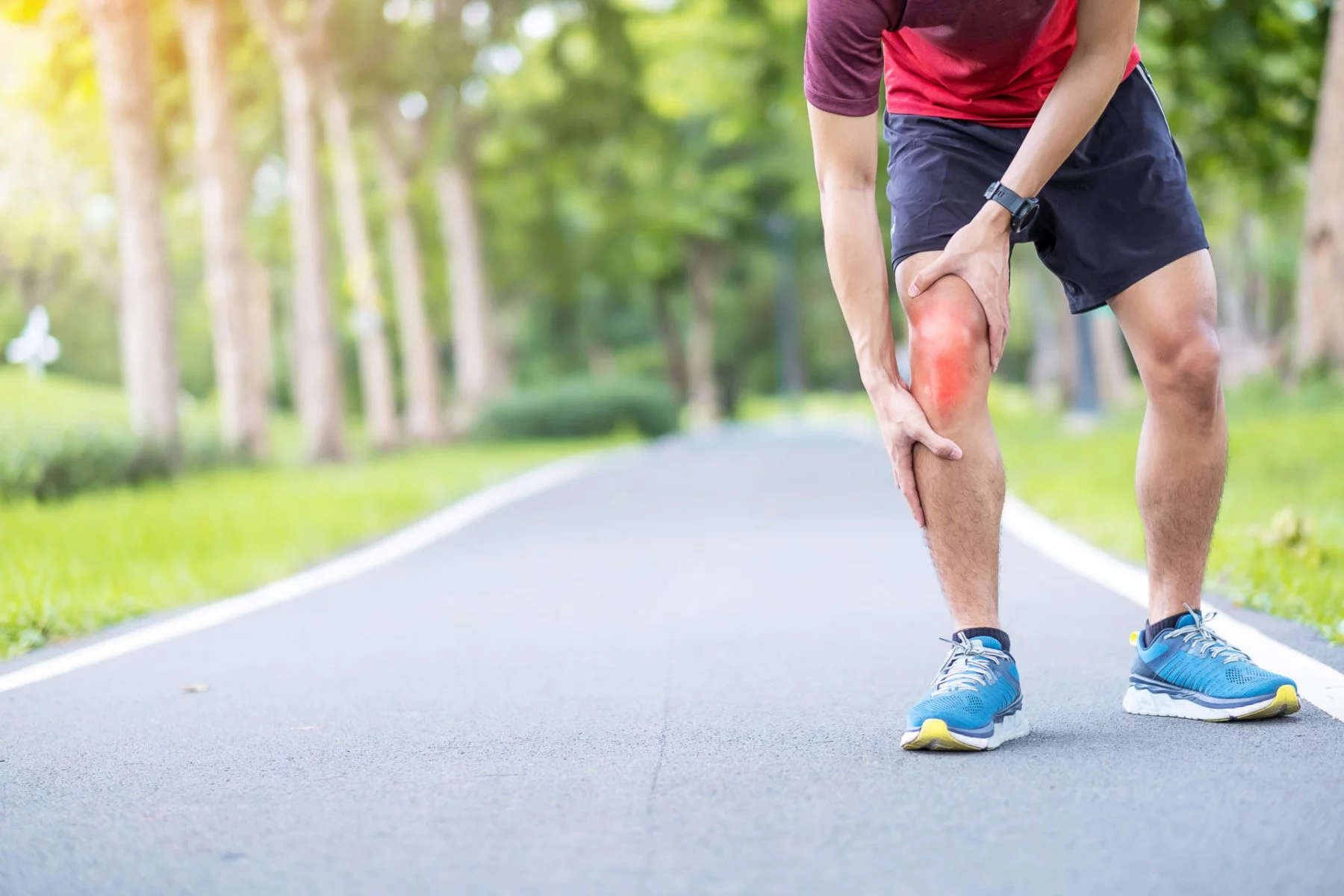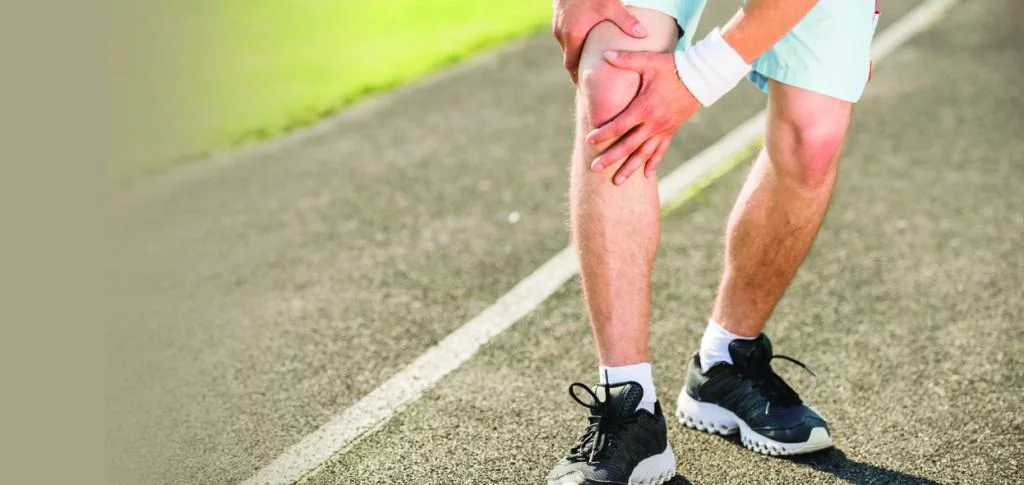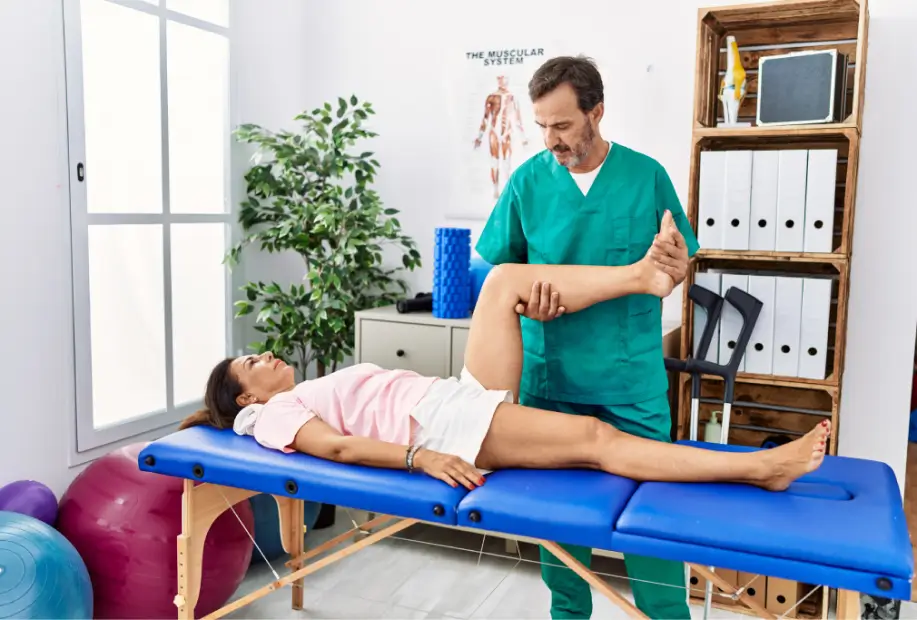
Runner’s knee, also known as patellofemoral syndrome, is a common issue among athletes. It involves ache at the front of the kneecap. This problem often stems from activities like running and basketball.
The pain feels dull inside the kneecap and gets worse when you stand up or move around.
Several factors lead to this condition. These include too much training, your kneecap not being right in place, weak muscles in your legs or hips, direct damage to your kneecap, and not warming up well before exercise.
All these can put stress on your knees and cause pain around your kneecap.

Moving from understanding to identifying, let’s look at the symptoms. Knowing these signs can help catch the condition early.
These symptoms point towards runner's knee and should prompt a visit to a specialist for help.
Runners face knee pain when their training gets too hard, the kneecap doesn’t sit right, or muscles are weak… among other reasons. Get ready to learn how to keep your knees happy and healthy!
Training too much is a big problem for patellofemoral syndrome. Your muscles and tissues need rest days to recover, especially after hard workouts. Without breaks, you’re more likely to hurt your knee.
This kind of injury makes it hard to do simple things like bend and straighten your leg.
Using the right schedule can help avoid putting too much stress on your legs. Mixing up your activities and not just running every day helps keep this balance. Remember, pushing too hard without enough rest ups the risk for serious pain around the kneecap area.
Poor kneecap alignment occurs when the patella doesn’t move correctly over the thighbone. This misalignment can lead to knee pain and problems, especially in runners. Factors like flat feet, high arches or knees that straighten too much can cause this issue.
It puts stress on the knee, making activities painful.
Keeping your kneecap aligned is key to avoiding pain. Proper footwear and exercises that strengthen thigh muscles help keep things in place. For some, shoe inserts or a visit to a physical therapist might be necessary to correct alignment issues.
This ensures your run is without pain and keeps your knees healthy.
A shallow groove in the femur can lead to knee issues, especially in runners. This condition makes it hard for the kneecap to slide correctly when you bend or straighten your leg. The movement should be smooth, but a shallow trench causes friction and pain at the front of the knee.
This problem often leads to aching discomfort during and after runs. It might also make your knee feel unstable as if it could give way under pressure. Regular actions like climbing stairs or sitting for long periods become harder and more painful.
Strengthening exercises targeting the muscles around the knee can help stabilise this joint, reducing pain and improving function over time.
Muscle weakness or imbalances can really throw off your knee health. If your ankles or hips aren’t strong enough, they put extra pressure on the knee joint. This often leads to runner’s knee.
Training the muscles in the front of your thigh is crucial for getting better from this problem. Focus especially on exercises for the Vastus Medialis Obliquus (VMO). These help a lot between zero and thirty degrees bending of the leg.
Electrostimulation is another great tool for those with weak VMO compared to their VL muscle. It gives that extra nudge needed for balance and strength in the affected area, supporting recovery without aggressive strain.
So, keeping those smaller lower limb and hip muscles fit goes a long way in preventing pesky knee issues that slow you down.
Hits or falls can hurt the kneecap badly. This kind of injury leads to pain and swelling in the knee area, known as runner’s knee. Running or other activities don’t cause it directly but getting hit directly on the kneecap does.
If your kneecap takes a hard knock, it might lead to issues that make running painful.
Not warming up properly before exercise can also harm your patella. Doing stretches and exercises strengthens muscles around your patella, helping avoid injuries. Next, let’s talk about inadequate warm-up routines and why they matter.
After discussing trauma to the patella, we must also consider the risks of not preparing your body properly before running. Skipping a thorough warm-up can seriously harm your knees.
This neglect can cause compressive forces and inflammation around the patella, leading to runner’s knee. A proper warm-up routine gets blood flowing to your muscles, tendons, and ligaments, making them more flexible and ready for action.
Not warming up means you’re asking your body to run without giving it a heads-up. Think of it like revving a cold engine; chances are something will go wrong. Your kneecap needs that gentle prep to glide smoothly over your femur as you move.
Without it, every step could be causing small injuries that add up over time, setting the stage for persistent knee pain. So, always start with stretches and light jogging to signal your legs—especially those thigh muscles—it’s time to work.

A physiotherapist will start with a thorough history intake. They’ll ask about how your knee pain started, where it hurts, what makes it worse, and any treatments you’ve tried before.
This step helps them understand your issue better and craft a custom plan just for you. Next comes the physical examination. Here, they’ll check how well you can move your knee, look for signs of pain or discomfort when bending or straightening the joint, and assess overall muscle balance.
Determining the exact cause of patellofemoral syndrome requires careful examination and sometimes additional tests like an x-ray might be needed to rule out other knee problems such as fractures or dislocations.
With all this information in hand, a tailored treatment strategy takes shape—a mixture of rest, exercises specifically designed to strengthen weak muscles around the knee, and possibly tools like orthotics for shoes if foot alignment is part of the problem.
Next up: How physiotherapy can help manage Runner’s Knee…
Physiotherapy offers a range of treatments to tackle runner’s knee head-on. This includes methods like applying cold packs, using supportive tapes, and doing special leg workouts to get you back on track.
Taking short breaks from running can help your body heal, especially if you’re dealing with runner’s knee. Letting your muscles and tissues recover is key. Resting doesn’t mean you have to stop all activities.
You can still do exercises that don’t put much stress on your knees.
Using cold packs is a good way to reduce swelling and pain. Put ice on your knee for about 15 minutes at a time, but not directly on the skin—wrap it in a cloth first. It’s also helpful to lift your leg higher than your heart whenever possible.
This helps decrease swelling by moving fluid away from the affected area.
Next up, let’s talk about targeted stretches that can further aid in managing symptoms of runner’s knee…
Targeted stretches offer immediate pain relief and better function for folks with Patellofemoral Pain Syndrome. These stretches aim at the muscles around the knee, improving flexibility and reducing stress on the patella.
Regular targeted stretching can not only provide short-term pain relief but also long-term functional improvements in individuals with Patellofemoral Pain Syndrome. Next up – let’s explore strength exercises that further aid in managing Runner's Knee.
After loosening up with targeted stretches, it’s time to build strength. Muscle weakness, especially in the ankles or hips, can lead to knee problems. Here are some key exercises:
Stand with feet hip-width apart. Bend knees and lower your backside as if sitting in a chair. Keep your chest lifted and back straight. This move targets thighs and glutes, helping stabilise knees.
Use a leg press machine at the gym for this. Place feet shoulder-width apart on the platform. Bend knees to lower the platform, then push it back up. It boosts muscle power around the knee.
Step forward with one leg, lowering hips until both knees are bent at about 90 degrees. Keep the front knee above your foot and don't let the other knee touch the floor. Push back to start position and switch legs. Lunges engage multiple muscles in your lower body for better support.
Stand upright, slowly lift onto your toes, hold, then lower back down. This strengthens calves, which support ankles—a critical factor for healthy knees.
Lie on one side; keep legs stacked and straight. Lift the top leg towards ceiling then lower it down without letting it touch the bottom leg—repeat on both sides to work inner and outer thighs along with hip abductors.
Find a step or bench that is stable enough to hold your weight safely when you step onto it with one foot; push through your heel to bring yourself up onto it; make sure you alternate legs for a balanced workout focusing on thigh muscles.
These exercises not only help prevent Runner’s Knee but also improve overall performance by ensuring that muscle imbalances do not throw off your form while running or participating in other activities that put stress on knees.
After building strength through exercises, moving on to taping methods can further support your knee. Taping provides the extra help and stability your joint needs during activities.
It works by keeping the kneecap in line and easing pain. This method uses special tape placed around the kneecap and muscles nearby. The goal is to improve how the kneecap moves and lower stress on the joint.
Using taping as part of treatment helps fix knee actions that cause too much pressure. It’s essential for getting back to sports or training without hurting your knee again. Combining education about movement, changing how you run, and considering mental factors completes this approach.
Taping plays a big role in healing knees by making movements smoother and less painful.
Moving from taping techniques, we see how custom orthotics play a crucial role in managing runner’s knee. These unique shoe inserts are made just for your feet. They consider how you walk and the structure of your feet to offer precise help where it’s needed.
The main goal is to balance pressure across your foot and lower part of the leg, making sure the patellofemoral joint isn’t overworked.
Using custom orthotics might lead to less pain, better movement, and stronger results if you have runner’s knee. They’re a key part of tackling this issue head-on – providing necessary support so that every step feels better.
Think of them as a strong ally in your journey towards overcoming patellofemoral pain syndrome by giving you stability right from the ground up.
Following custom orthotics, knee bracing plays a key role in managing Runner’s Knee, or Patellofemoral Pain Syndrome. These supports help to stabilise the kneecap and align it properly.
This can reduce pain and aid in recovery. Braces come in different styles, each designed for specific needs.
Wearing a brace can make physical activities more comfortable by supporting the lower leg bones during motion. They also assist in keeping the kneecap from moving out of place. For many runners, this means less discomfort while running or doing other exercises that put stress on their knees.
To fend off Runner’s Knee, perfecting your running style, warming up right, making workout shifts slowly, and choosing the right trainers are key. Get details on keeping those knees happy—explore more!
Correct running form keeps your knees safe. Keep your body upright and look ahead, not down at your feet. Your arms should move smoothly at your sides, not across your body. This balance helps prevent runner’s knee.
Land softly on the middle of your foot then roll forward to push off from the toes. Small steps are better than big leaps.
Strengthening exercises for hip external rotator muscles help too. These muscles keep the hips stable when you run, which takes pressure off the knees. Use a resistance band around your legs just above the knees and walk sideways in a squat position to work these muscles.
Proper form combined with strong hip muscles reduces stress on the knees and lowers injury risk.
Warming up is key to preventing Runner’s Knee. It gets your muscles ready and helps avoid injuries. Here’s a step-by-step guide to a proper warm-up routine:
Strengthening exercises targeting hip and knee muscles can really help avoid Runner’s Knee issues.
Next up, let’s explore how physiotherapy treatments can help further address Runner’s Knee concerns…
Gradual workout changes are key to preventing Runner’s Knee. This approach helps your body adjust without strain.
Each of these steps is crucial for mid-aged athletes looking to keep their knees healthy while following their passion for running.
Choosing the right running trainers can make a big difference in preventing runner’s knee. Shoes that fit well help keep your kneecap aligned and reduce stress on your knee joints during runs.
They act like a shield for your feet, absorbing shock and supporting each step. This means less wear and tear on the cartilage under your kneecap, lowering the risk of pain around this area.
It’s not just about comfort; it’s about health too. Proper footwear prevents overuse injuries by correcting imbalances or weaknesses in how you walk or run. The benefits are clear: fewer aches and longer running distances without discomfort.
Next, let’s look into why starting with a proper warm-up routine is crucial for every runner.
Runner’s Knee hurts. It comes from running, skiing, or even walking up stairs. We have learned why it happens—things like overtraining and weak muscles play a big role. Fixing it can be simple with rest, stretching, and proper shoes.
Making these changes not only helps your knee but also boosts your overall fitness game.
Think of each step as moving closer to pain-free knees. You’re not alone; many athletes go through this. The right exercises and gear make a big difference. If you ever feel stuck, physiotherapists are there to guide you.
Taking action now prevents more pain later on. Your knees will thank you for the care and effort you put in today. So keep pushing forward, one healthy step at a time!
Runner’s knee, known medically as patellofemoral pain syndrome, involves aching pain around the kneecap. It occurs when the knee bends and straightens repeatedly.
It often results from repeated stress on the knee — things like deep squats or running can increase this risk. Poor alignment of the lower extremity and muscular imbalances may also contribute.
Yes, while it’s more common among runners and those active in sports that involve a lot of leg work, anyone can experience it due to overuse or improper form during activities.
Doctors examine how you bend and straighten your knee, check for signs of malalignment or muscular imbalance, and may discuss your exercise habits to diagnose patellofemoral pain syndrome.
Treatments include rest, NSAIDs like ibuprofen or naproxen for pain relief, specific exercises aimed at stretching and strengthening the hip abductor muscles and gluteals to improve alignment — sometimes physical therapy is recommended too.
Absolutely! Avoid activities that put repeated stress on your knees; focus on proper form during exercises; strengthen your hips, pelvis area, and lower legs with targeted exercises — all these steps help keep your kneecap aligned properly.